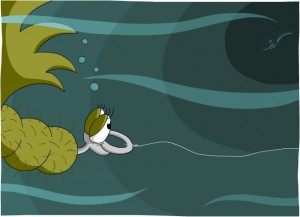When we fishing types head out to a stream or lake or other body of water with rod in hand, what is it that we are really doing? Some will say that they’re just out to enjoy the fishing, and catching is just icing on the cake. Others are less philosophical: their desire is to simply catch a fish. Others still may be more specific with their intent, admitting (openly or not) that they want to catch a big fish.
Those who fly fish know that the biggest fish rarely rise to a dry fly. Several reasons account for this, none of which may or may not be right, but let’s speculate. When a fish rises to the surface to take a real bug or an imitation fly, they momentarily leave themselves vulnerable to attack from raptors, among other things. There are also other critters that would also love to make a meal of a fish should the opportunity present itself. That opportunity is created when the fish leaves the relative safety of deep water and the shelter provided by a cut bank or structure (weeds, sunken logs, rocks, etc). So it stands to reason that the fish that remain in the safety of deeper, darker waters tend to survive to feed another day.
Big fish don’t reach their esteemed position in the food chain by being reckless or chasing every tiny bug that presents itself. That’s why when we fish with dry flies we’re not often going to catch the bigg’uns. I enjoy throwing dries and catching cookie-cutter sized fish. It’s fun. It provides entertainment. It fills a certain need. And while fishing is about much more than catching fish, I’ll admit that sometimes what I really want is to be holding onto a taco-bent rod. Sometimes I want to catch that big fish. I’ve caught some nice fish, but nothing extraordinary.
Therein lies the beauty of the streamers, of which the woolly bugger is one of if not THE best overall patterns. If the author angler presents a woolly bugger in the desired depths of the water column, they are putting their fly where the fish are. The big fish. Streamers represent substantial meals that are high in protein. Big fish don’t waste their time chasing snacks—they want a return on their investment in energy spent to chase food. They’re selective. Big fish are eat meaters.
I’ve fished the surface and been rewarded with small fish. Don’t get me wrong—I am grateful for the opportunity and privilege to play these small fish, and I do not take them for granted. Every small fish has made me a better angler and caused me to appreciate the sport much more so than if I had landed a 48″ steelhead on my first cast. I will always seek out small streams with game little fish that provide much-needed action, but the time has come that I am admittedly hankering for something much, much bigger. Will I actually catch that big fish? I only know for certain that I stand absolutely no chance unless I go fishing.
So fishing I am. I’ve tied on a woolly bugger, and her name is Olive. It’s time to see what she can entice out of hiding. I’m confident there’s a big fish out there, somewhere, looking for a tasty meal.
(The author may have been engaging in the use of metaphors in this article)



